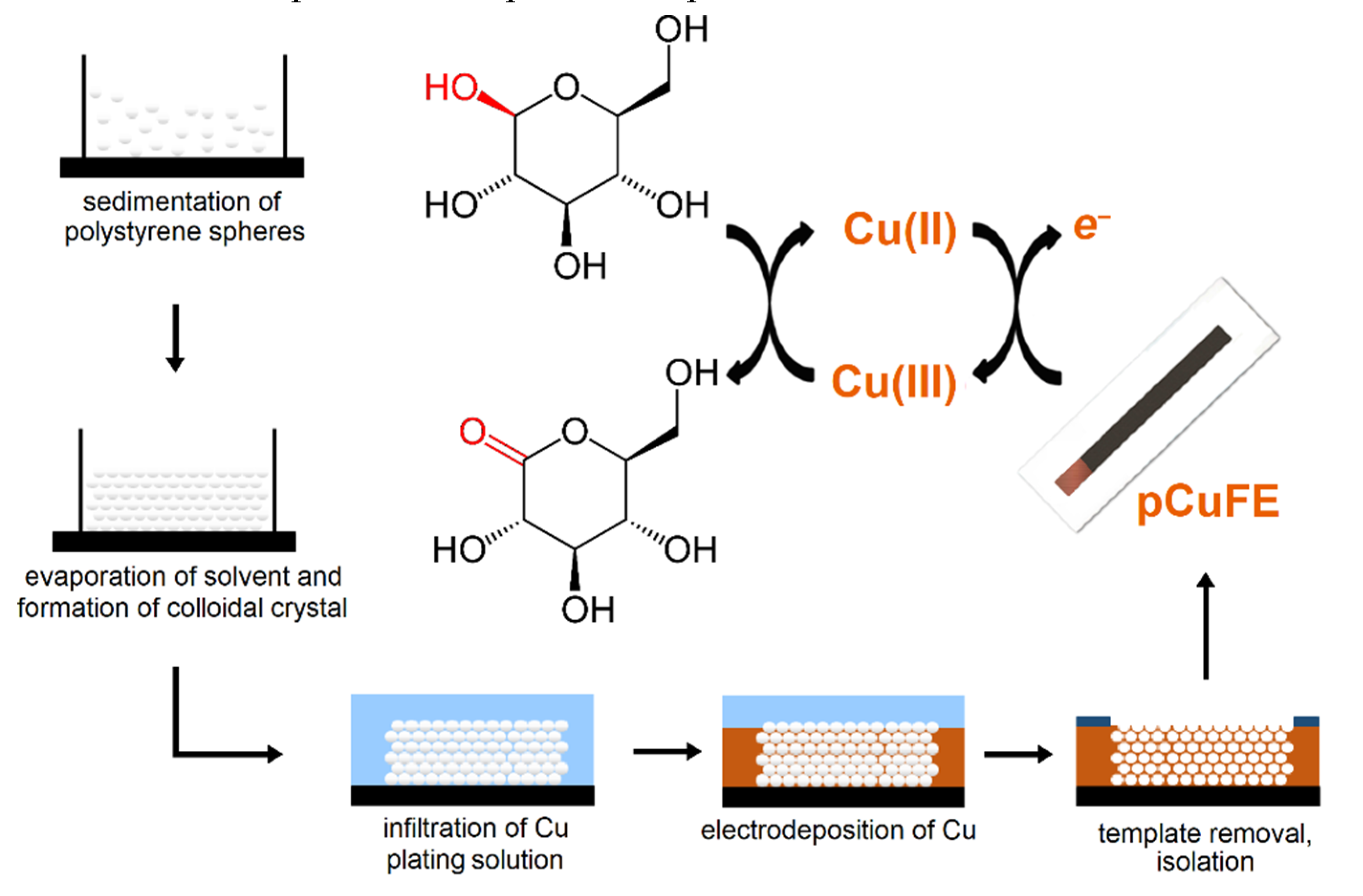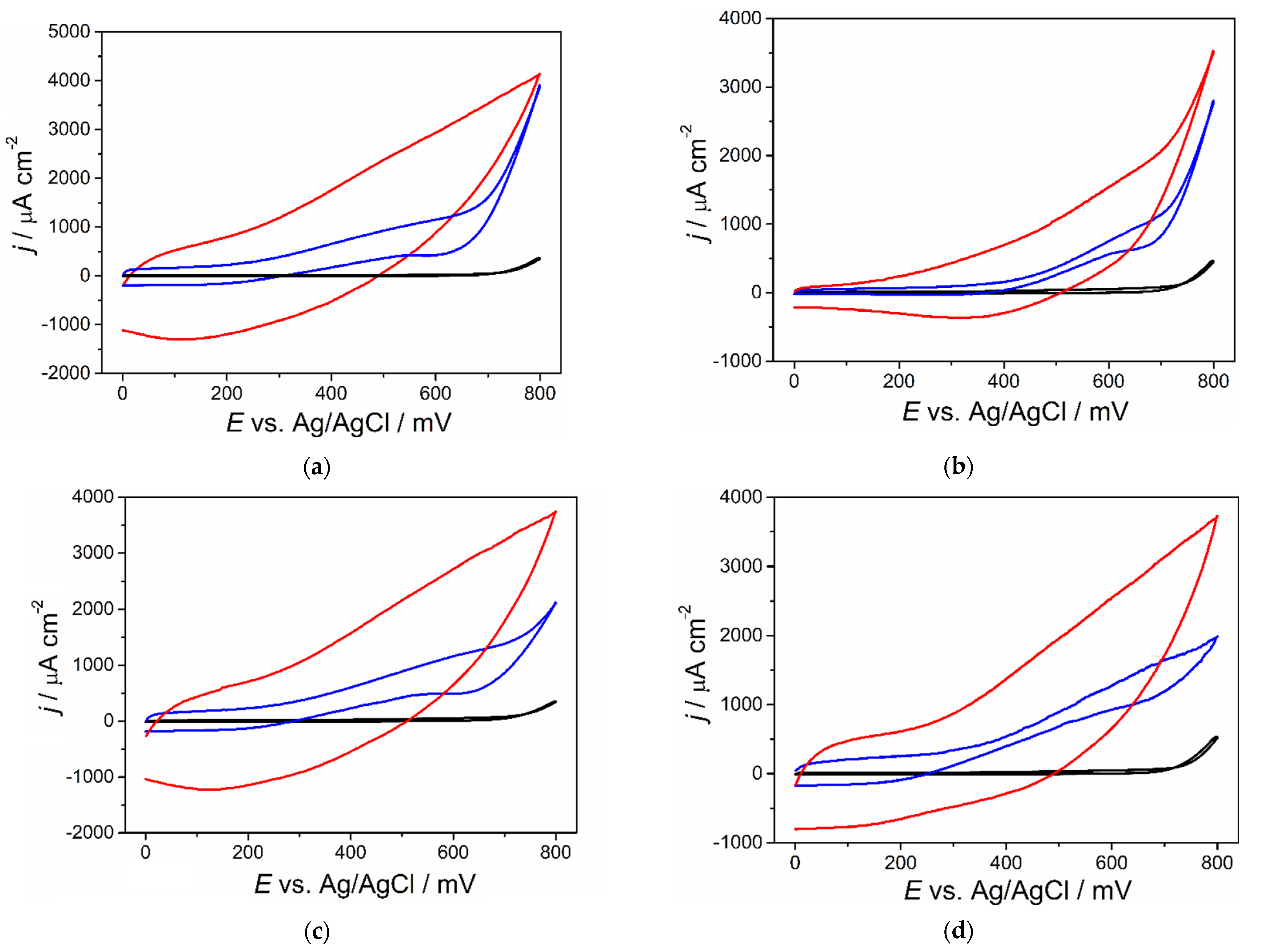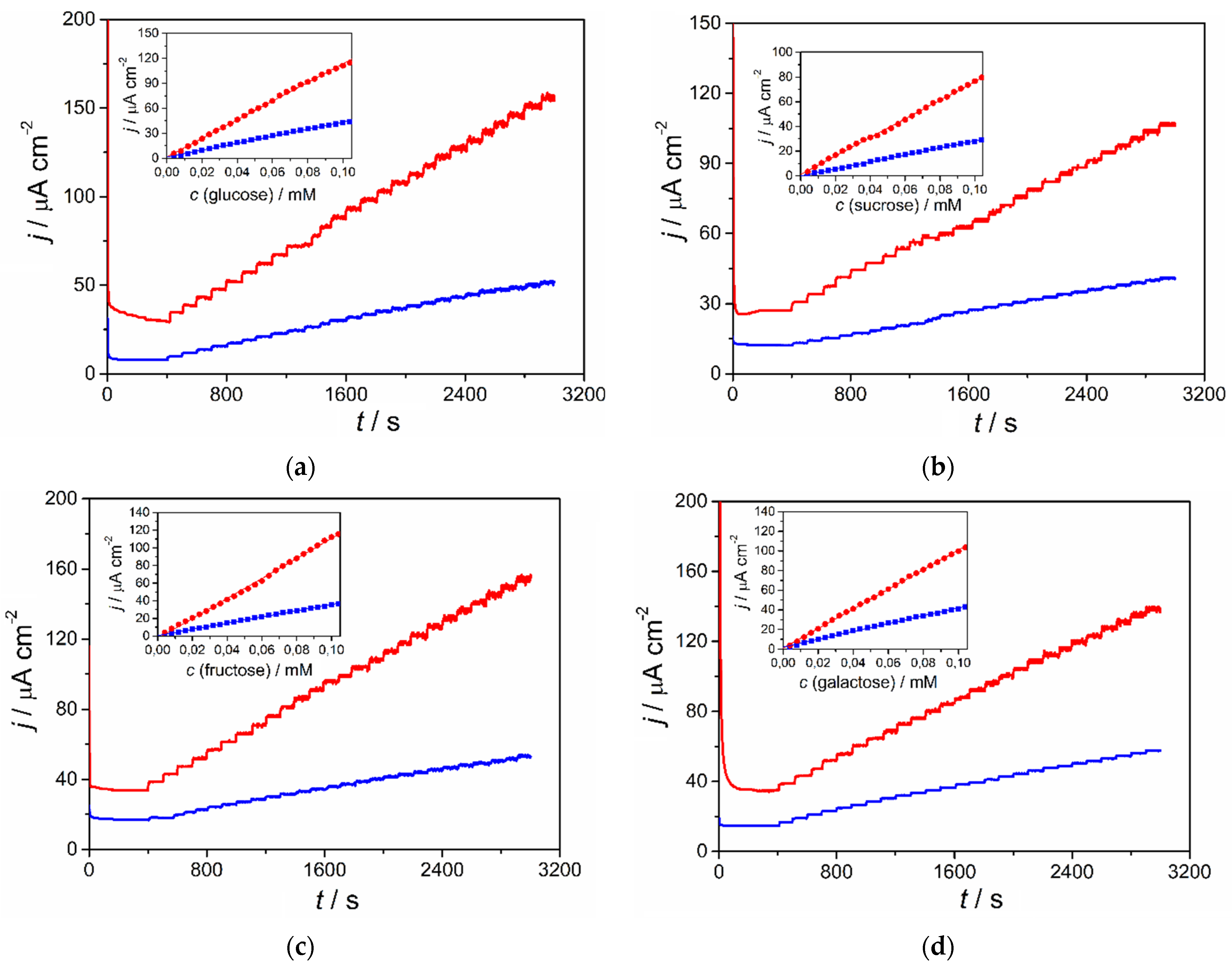Screen-Printed Carbon Electrodes with Macroporous Copper Film for Enhanced Amperometric Sensing of Saccharides
Abstract
:1. Introduction
2. Materials and Methods
2.1. Chemicals
2.2. Apparatus
2.3. Preparation of Screen-Printed Carbon Electrodes
2.4. Preparation of Copper Film Electrodes
2.5. Preparation of pCuFEs
2.6. Methods
3. Results and Discussion
3.1. Preparation of pCuFEs
3.1.1. Colloidal Crystal Templating
3.1.2. Electrodeposition of Copper Film
3.2. Electrochemical Characterization of Porous CuFE
3.3. Analytical Performance of the pCuFE in the Electrochemical Detection of Saccharides
3.4. Interference Study and Repeatability
4. Conclusions
Author Contributions
Funding
Informed Consent Statement
Data Availability Statement
Conflicts of Interest
References
- Lee, H.; Hong, Y.J.; Baik, S.; Hyeon, T.; Kim, D.H. Enzyme based glucose sensor: From invasive to wearable device. Adv. Healthc. Mater. 2018, 7, 1701150. [Google Scholar] [CrossRef] [PubMed] [Green Version]
- Lee, W.C.; Kim, K.B.; Gurudatt, N.G.; Hussain, K.K.; Choi, C.S.; Park, D.S.; Shim, Y.B. Comparison of enzymatic and non-enzymatic glucose sensors based on hierarchical Au-Ni alloy with conductive polymer. Biosens. Bioelectron. 2019, 130, 48–54. [Google Scholar] [CrossRef]
- Ruiz Altisent, M.; Ruiz-Garcia, L.; Moreda, G.P.; Lu, R.; Hernandez-Sanchez, N.; Correa, E.C.; Diezma, B.; Nicolaï, B.; García Ramos, J. Sensors for product characterization and quality of specialty crops-A review. Comput. Electron. Agric. 2010, 74, 176–194. [Google Scholar] [CrossRef] [Green Version]
- Espro, C.; Marini, S.; Giusi, D.; Ampelli, C.; Neri, G. Non-enzymatic screen printed sensor based on Cu2O nanocubes for glucose determination in bio-fermentation processes. J. Electroanal. Chem. 2020, 837, 114354. [Google Scholar] [CrossRef]
- Luiz da Silva, J.; Buffon, E.; Beluomini, M.A.; Pradela Filho, L.A.; Araújo, D.A.G.; Santos, A.L.; Takeuchi, R.M.; Stradiotto, N.R. Non-enzymatic lactose molecularly imprinted sensor based on disposable graphite paper electrode. Anal. Chim. Acta 2021, 1143, 53–64. [Google Scholar] [CrossRef] [PubMed]
- Niu, X.H.; Li, Y.X.; Tang, J.; Hu, Y.L.; Zhao, H.L.; Lan, M.B. Electrochemical sensing interfaces with tunable porosity for nonenzymatic glucose detection: A Cu foam case. Biosens. Bioelectron. 2014, 51, 22–28. [Google Scholar] [CrossRef] [PubMed]
- Liu, S.; Zeng, W.; Guo, Q.; Li, Y. Metal oxide-based composite for non-enzymatic glucose sensors. J. Mater. Sci. Mater. Electron. 2020, 31, 16111–16136. [Google Scholar] [CrossRef]
- Lu, W.; Sun, Y.; Dai, H.; Ni, P.; Jiang, S.; Wang, Y.; Li, Z.; Li, Z. CuO nanothorn arrays on three-dimensional copper foam as an ultra-highly sensitive and efficient nonenzymatic glucose sensor. RSC Adv. 2016, 6, 16474–16480. [Google Scholar] [CrossRef]
- Shackery, I.; Patil, U.; Pezeshki, A.; Shinde, N.M.; Kang, S.; Im, S.C. Copper hydroxide nanorods decorated porous graphene foam electrodes for non-enzymatic glucose sensing. Electrochim. Acta 2016, 191, 954–961. [Google Scholar] [CrossRef]
- Liu, X.; Yang, X.; Chen, L.; Jia, J. Three-dimensional copper foam supported CuO nanowire arrays: An efficient non-enzymatic glucose sensor. Electrochim. Acta 2017, 235, 519–526. [Google Scholar] [CrossRef]
- Kumar, K.P.A.; Ghosh, K.; Alduhaish, O.; Pumera, M. Metal-plated 3D printed electrode for electrochemical detection of carbohydrates. Electrochem. Commun. 2020, 120, 106827. [Google Scholar] [CrossRef]
- Bie, L.; Luo, X.; Kang, L.; He, D.; Jiang, P. Commercial copper foam as an effective 3D porous electrode for nonenzymatic glucose detection. Electroanalysis 2016, 28, 2070–2074. [Google Scholar] [CrossRef]
- Liu, W.; Wu, X.; Li, X. Gold nanorods on three-dimensional nickel foam: A non-enzymatic glucose sensor with enhanced electro-catalytic performance. RSC Adv. 2017, 7, 36744. [Google Scholar] [CrossRef] [Green Version]
- Cao, X.; Wang, N. A novel non-enzymatic glucose sensor modified with Fe2O3 nanowire arrays. Analyst 2011, 136, 4241. [Google Scholar] [CrossRef] [PubMed]
- Sattarahmady, N.; Heli, H. A non-enzymatic amperometric sensor for glucose based on cobalt oxide nanoparticles. J. Exp. Nanosci. 2012, 7, 529–546. [Google Scholar] [CrossRef] [Green Version]
- Chen, J.; Zhang, W.D.; Ye, J.S. Nonenzymatic electrochemical glucose sensor based on MnO2/MWNTs nanocomposite. Electrochem. Commun. 2008, 10, 1268–1271. [Google Scholar] [CrossRef]
- Ahmad, R.; Tripathy, N.; Ahn, M.S.; Bhat, K.S.; Mahmoudi, T.; Wang, Y.; Yoo, J.Y.; Kwon, D.W.; Yang, H.Y.; Hahn, Y.B. Highly efficient non-enzymatic glucose sensor based on CuO modified vertically-grown ZnO nanorods on electrode. Sci. Rep. 2017, 7, 5715. [Google Scholar] [CrossRef] [Green Version]
- Zhao, Y.; Bo, Y.; Guo, L. Highly exposed copper oxide supported on three-dimensional porous reduced graphene oxide for non-enzymatic detection of glucose. Electrochim. Acta 2015, 176, 1272–1279. [Google Scholar] [CrossRef]
- Zhang, L.; Ni, Y.; Li, H. Addition of porous cuprous oxide to a Nafion film strongly improves the performance of a nonenzymatic glucose sensor. Microchim. Acta 2010, 171, 103–108. [Google Scholar] [CrossRef]
- Azharudeen, A.M.; Suriyakala, T.; Rajarajan, M.; Suganthi, A. An improved sensitive and selective non-enzymatic glucose biosensor based on PEG assisted CuO nanocomposites. Egypt. J. Chem. 2019, 62, 487–500. [Google Scholar] [CrossRef] [Green Version]
- Cherevko, S.; Chung, C.H. The porous CuO electrode fabricated by hydrogen bubble evolution and its application to highly sensitive non-enzymatic glucose detection. Talanta 2010, 80, 1371–1377. [Google Scholar] [CrossRef] [PubMed]
- Zhao, X.X.; Li, Y.P.; He, Z.Y.; Yan, Z.F. Facile preparation of Cu–Cu2O nanoporous nanoparticles as a potential catalyst for non-enzymatic glucose sensing. RSC Adv. 2013, 3, 2178–2181. [Google Scholar] [CrossRef]
- Jin, J.; Ge, Y.; Zheng, G.; Cai, Y.; Liu, W.; Hui, G. d-glucose, d-galactose, and d-lactose non-enzyme quantitative and qualitative analysis method based on Cu foam electrode. Food Chem. 2015, 175, 485–493. [Google Scholar] [CrossRef]
- Zhang, L.; Li, H.; Ni, Y.N.; Li, J.; Liao, K.M.; Zhao, G.C. Porous cuprous oxide microcubes for non-enzymatic amperometric hydrogen peroxide and glucose sensing. Electrochem. Commun. 2009, 11, 812–815. [Google Scholar] [CrossRef]
- Zhou, D.L.; Feng, J.J.; Cai, L.Y.; Fang, Q.X.; Chen, J.R.; Wang, A.J. Facile synthesis of monodisperse porous Cu2O nanospheres on reduced graphene oxide for non-enzymatic amperometric glucose sensing. Electrochim. Acta 2014, 115, 103–108. [Google Scholar] [CrossRef]
- Li, Z.; Chen, Y.; Xin, Y.; Zhang, Z. Sensitive electrochemical nonenzymatic glucose sensing based on anodized CuO nanowires on three-dimensional porous copper foam. Sci. Rep. 2015, 5, 16115. [Google Scholar] [CrossRef] [Green Version]
- Velev, O.D.; Lenhoff, A.M. Colloidal crystals as templates for porous materials. Curr. Opin. Colloid Interface Sci. 2000, 5, 56–63. [Google Scholar] [CrossRef]
- Toghill, K.E.; Compton, R.G. Electrochemical non-enzymatic glucose sensors: A perspective and an evaluation. Int. J. Electrochem. Sci. 2010, 5, 1246–1301. [Google Scholar]
- Shiba, S.; Maruyama, R.; Kamata, T.; Kato, D.; Niwa, O. Chromatographic determination of sugar probes used for gastrointestinal permeability test by employing nickel copper nanoalloy embedded in carbon film electrodes. Electroanalysis 2018, 30, 1407–1415. [Google Scholar] [CrossRef]
- Poorahong, S.; Thammakhet, C.; Thavarungkul, P.; Kanatharana, P. One-step preparation of porous copper nanowires electrode for highly sensitive and stable amperometric detection of glyphosate. Chem. Pap. 2015, 69, 385–394. [Google Scholar] [CrossRef]
- Zhu, H.; Li, L.; Zhou, W.; Shao, Z.; Chen, X. Advances in non-enzymatic glucose sensors based on metal oxides. J. Mater. Chem. B 2016, 4, 7333–7349. [Google Scholar] [CrossRef]
- Dal Borgo, S.; Sopha, H.; Smarzewska, S.; Hocevar, S.B.; Svancara, I.; Metelka, R. Macroporous bismuth film screen-printed carbon electrode for simultaneous determination of Ni(II) and Co(II). Electroanalysis 2015, 27, 209–216. [Google Scholar] [CrossRef]
- Urbanová, V.; Bartoš, M.; Vytřas, K.; Kuhn, A. Porous bismuth film electrodes for signal increase in anodic stripping voltammetry. Electroanalysis 2010, 22, 1524–1530. [Google Scholar] [CrossRef]
- Urbanová, V.; Vytřas, K.; Kuhn, A. Macroporous antimony film electrodes for stripping analysis of trace heavy metals. Electrochem. Commun. 2010, 12, 114–117. [Google Scholar] [CrossRef]
- Walcarius, A.; Kuhn, A. Ordered porous thin films in electrochemical analysis. TrAC Trends Anal. Chem. 2008, 27, 593–603. [Google Scholar] [CrossRef]
- Józwik, M.; Józwik, M.; Teng, C.; Battaglia, F.C. Concentrations of monosaccharides and their amino and alcohol derivatives in human preovulatory follicular fluid. Mol. Hum. Reprod. 2007, 13, 791–796. [Google Scholar] [CrossRef] [Green Version]
- Ning, C.; Segal, S. Plasma galactose and galactitol concentration in patients with galactose-1-phosphate uridyltransferase deficiency galactosemia: Determination by gas chromatography/mass spectrometry. Metabolism 2000, 49, 1460–1466. [Google Scholar] [CrossRef]
- Pitkänen, E.; Kanninen, T. Determination of mannose and fructose in human plasma using deuterium labelling and gas chromatography/mass spectrometry. Biol. Mass Spectrom. 1994, 23, 590–595. [Google Scholar] [CrossRef]
- Sun, S.Z.; Empie, M.W. Fructose metabolism in humans–what isotopic tracer studies tell us. Nutr. Metab. 2012, 9, 89. [Google Scholar] [CrossRef] [Green Version]
- Apthorp, G.H. Investigation of the sugar content of urine from normal subjects and patients with renal and hepatic disease by paper chromatography. J. Clin. Pathol. 1957, 10, 84–87. [Google Scholar] [CrossRef] [Green Version]
- Wei, M.; Gibbons, L.W.; Mitchell, T.L.; Kampert, J.B.; Stern, M.P.; Blair, S.N. Low fasting plasma glucose level as a predictor of cardiovascular disease and all-cause mortality. Circulation 2000, 101, 2047–2052. [Google Scholar] [CrossRef] [PubMed] [Green Version]
- Van Loon, G.R.; Sole, M.J. Plasma dopamine: Source, regulation, and significance. Metabolism 1980, 29, 1119–1123. [Google Scholar] [CrossRef]
- Hodis, J. New facts about paracetamol, risks of overdose, intoxication and their management. Pract. Pharm. 2015, 11, 90–92. [Google Scholar]
- Frangu, A.; Pravcová, K.; Šilarová, P.; Arbneshi, T.; Sýs, M. Flow injection tyrosinase biosensor for direct determination of acetaminophen in human urine. Anal. Bioanal. Chem. 2019, 411, 2415–2424. [Google Scholar] [CrossRef] [PubMed]
- Kabasakalis, V.; Siopidou, D.; Moshatou, E. Ascorbic acid content of commercial fruit juices and its rate of loss upon storage. Food Chem. 2000, 70, 325–328. [Google Scholar]





| Sensor | Saccharide | Sensitivity (µA L mmol−1 cm−2) | Linear Range (µmol L−1) | LOD (µmol L−1) | Ed (V) | Medium | Selectivity | Ref. |
|---|---|---|---|---|---|---|---|---|
| CuF | Glucose | 2570, 1810 | 2–80, 100–5000 | 0.98 | +0.35 | 0.10 mol L−1 NaOH | AA, UA, DA, APAP | [6] |
| CuONHs | Glucose | 5984 | 0.2–2000 | 0.3 | +0.50 | 0.10 mol L−1 NaOH | AA, UA, Suc, Mal, Lac | [8] |
| Cu(OH)2/PGF | Glucose | 3360 | 1.2–6000 | 1.2 | +0.60 | 1.0 mmol L−1 NaOH | AA, UA, DA, Frc, Lac | [9] |
| CuONWA/CF | Glucose | 32,330 | 0.1–500 | 0.02 | +0.50 | 0.10 mol L−1 NaOH | AA, UA, DA, Frc, Lac, Mal, Sor | [10] |
| CuF | Glucose | 5850 | 1–500 | 0.5 | +0.55 | 0.10 mol L−1 NaOH | AA, DA, UA | [12] |
| CuO/PrGO | Glucose | 33 | 1–6000 | 0.05 | +0.55 | 0.10 mol L−1 NaOH | [18] | |
| pCuO/Nafion® | Glucose | 11 | 2–350 | 1.3 | +0.40 | 0.10 mol L−1 NaOH | AA, UA | [19] |
| pCuOF | Glucose | 2900 | 1–2500 | 0.14 | +0.65 * | 0.10 mol L−1 NaOH | AA, UA | [21] |
| Cu–Cu2ONN | Glucose | 124 | 10–5500 | 0.05 | +0.60 | 0.10 mol L−1 NaOH | AA, DA, UA | [22] |
| CuFME | Glucose | 1790 | 180–3470 | 9.3 | +0.50 | 0.10 mol L−1 NaOH | [23] | |
| CuFME | Galactose | 570 | 180–3470 | 29.4 | +0.50 | 0.10 mol L−1 NaOH | [23] | |
| CuFME | Lactose | 640 | 180–3470 | 26 | +0.50 | 0.10 mol L−1 NaOH | [23] | |
| pCu2OM | Glucose | 71 | up to 500 | 0.8 | +0.61 | 0.10 mol L−1 NaOH | [24] | |
| RGOs-Cu2O | Glucose | 185 | 10–6000 | 0.05 | +0.60 ** | 0.05 mmol L−1 KOH | AA, DA, UA | [25] |
| CuO-NWs/CF | Glucose | 2217 | 1–18,800 | 0.3 | +0.35 | 0.10 mol L−1 NaOH | AA, UA, DA | [26] |
| pCuFE | Glucose | 34, 11 | 0.2–1, 4–100 | 0.1 | +0.60 | 0.10 mol L−1 NaOH | AA, UA | [This work] |
| pCuFE | Fructose | 50, 11 | 0.2–1, 4–100 | 0.03 | +0.60 | 0.10 mol L−1 NaOH | AA, UA | [This work] |
| pCuFE | Sucrose | 54, 8 | 0.2–1, 4–100 | 0.05 | +0.60 | 0.10 mol L−1 NaOH | AA, UA | [This work] |
| pCuFE | Galactose | 53, 10 | 0.2–1, 4–100 | 0.05 | +0.60 | 0.10 mol L−1 NaOH | AA, UA | [This work] |
Publisher’s Note: MDPI stays neutral with regard to jurisdictional claims in published maps and institutional affiliations. |
© 2022 by the authors. Licensee MDPI, Basel, Switzerland. This article is an open access article distributed under the terms and conditions of the Creative Commons Attribution (CC BY) license (https://creativecommons.org/licenses/by/4.0/).
Share and Cite
Metelka, R.; Vlasáková, P.; Smarzewska, S.; Guziejewski, D.; Vlček, M.; Sýs, M. Screen-Printed Carbon Electrodes with Macroporous Copper Film for Enhanced Amperometric Sensing of Saccharides. Sensors 2022, 22, 3466. https://doi.org/10.3390/s22093466
Metelka R, Vlasáková P, Smarzewska S, Guziejewski D, Vlček M, Sýs M. Screen-Printed Carbon Electrodes with Macroporous Copper Film for Enhanced Amperometric Sensing of Saccharides. Sensors. 2022; 22(9):3466. https://doi.org/10.3390/s22093466
Chicago/Turabian StyleMetelka, Radovan, Pavlína Vlasáková, Sylwia Smarzewska, Dariusz Guziejewski, Milan Vlček, and Milan Sýs. 2022. "Screen-Printed Carbon Electrodes with Macroporous Copper Film for Enhanced Amperometric Sensing of Saccharides" Sensors 22, no. 9: 3466. https://doi.org/10.3390/s22093466
APA StyleMetelka, R., Vlasáková, P., Smarzewska, S., Guziejewski, D., Vlček, M., & Sýs, M. (2022). Screen-Printed Carbon Electrodes with Macroporous Copper Film for Enhanced Amperometric Sensing of Saccharides. Sensors, 22(9), 3466. https://doi.org/10.3390/s22093466







